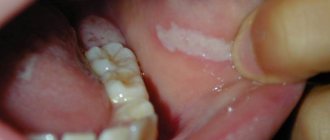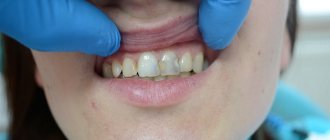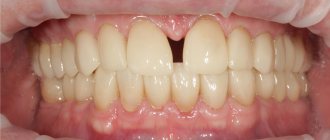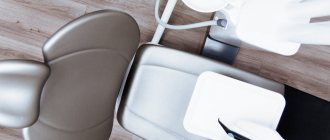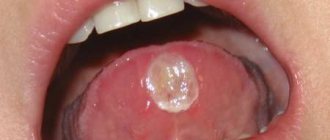Symptoms of periodontitis
Let's start with the fact that in the initial stages the disease occurs without symptoms, and it can only be detected at a dentist's appointment; this will require an x-ray. Symptoms appear in the stage of acute periodontitis or as a result of exacerbation of the chronic form. Among the signs of the disease:
- sharp or aching pain;
- swelling of the gums in the affected area;
- feeling as if the tooth has become taller;
- temperature increase;
- sleep disturbance;
- tooth mobility;
- tissue redness;
- pain when touching a tooth or chewing food.
If at least two symptoms occur, contact your dentist.
Possible consequences of an over-inflated filling:
- When the filling is too high, an increased load falls on the tooth; when the mouth is closed, the teeth of the opposite jaw put pressure on the filling. Thus, chronic tooth injury occurs. Constant pressure on the tooth can lead to traumatic pulpitis and periodontitis. As a result, the tooth will need to be depulped.
- With constant increased load on the filling, there is a risk of its chipping, as well as the chipping of the tooth wall.
- If, when closing the mouth, the teeth close together on one side (on an over-inflated filling), but the teeth on the other side do not close, then a kind of “distortion” occurs; the lower jaw may move to the side when closing the mouth. If you tolerate such an inconvenience, your body will eventually get used to it and stop noticing it. However, the problem will remain. The unusual position of the lower jaw when closing the teeth and blocking its lateral displacements can lead to diseases of the temporomandibular joints. Pain, crunching, clicking in the joints of the lower jaw - all this can be a symptom of a disease, which can be caused by over-inflated fillings.
Stages and forms of the disease
Periodontitis is divided according to the general principle into chronic and acute. Chronic cannot be completely cured. It is only possible to eliminate local inflammation and stop further exacerbation of the disease. Chronic periodontitis is asymptomatic and does not bother the carrier, but in case of exacerbation of the disease, symptoms begin to appear. In a calm state, a small fistula may appear on the gum from time to time, and slight discomfort may occur when chewing food or mechanical impact on the area of inflammation. If left untreated for a long time, the risk of tooth loss is high.
Treatment of acute periodontitis has an end result. But even after complete recovery, control over the oral cavity is necessary to avoid re-inflammation. In acute periodontitis, all of the listed symptoms are characteristic, only 2-3 of them may appear, and this is already a signal to visit the dentist. Purulent periodontitis is especially pronounced. In this case, the pain is acute, body temperature rises, and gumboil formation is possible.
Forms of periodontitis:
- Fibrous. In this case, periodontal tissue is replaced by fibrous tissue. It is often asymptomatic and can be detected by external signs: changes in enamel color, bad breath, pulp death.
- Granulating. It leaks quickly and destroys bone tissue. It is characterized by painful sensations when pressing on the gums or chewing food. A pulling or bursting pain may be observed without mechanical impact on the tooth.
- Granulomatous. This is a dangerous type of disease because it is asymptomatic, while destructive processes take place inside the periodontium, which are accompanied by the appearance of cysts and granulomas. If left untreated, the tooth may simply fall out. An infection locked in a granuloma or cyst can “explode” under the influence of the slightest irritant: provoke inflammation (for example, sepsis).
- Apical. The simplest form, easy to treat. It occurs as a result of untreated pulpitis and is localized in one place near the root.
Is the filling in the way? Don't be patient!
Has it ever happened that the doctor treated your tooth, put a filling, and when you came home, you felt that the filling was too high, there was discomfort when closing your mouth, and the rest of your teeth did not close?
Unfortunately, this situation occurs quite often. After placing the filling, the doctor polishes it according to the bite: gives the patient a carbon copy to bite, asks if the filling is in the way, adjusts it and polishes it. However, even an extra millimeter of filling, invisible to the doctor’s eye, can be felt by the patient as something foreign on the tooth and cause discomfort. While local anesthesia is in effect and the feeling of numbness remains, it is difficult for the patient to determine whether the filling is in the way. Only when the anesthesia finally wears off does the patient realize that it is inconvenient for him to close his teeth.
In such cases, many people think: “Nothing, it will wear off over time, I’ll get used to it!” Under no circumstances should you endure and wait for the filling to “settle down”, wear off, etc. Modern filling materials are very durable and resistant to abrasion. It can take years for the extra millimeter of filling to wear off. You shouldn’t get used to discomfort either, because... overestimation of the tooth can lead to negative consequences. It is also important that the filling does not block the movements of the lower jaw. You can check this this way: close your teeth, try to move your lower jaw left, right, forward (without opening your mouth wide). If the movements are the same as before the filling was placed, then everything is fine. If you feel that the filling prevents you from moving your lower jaw in any direction, be sure to inform your doctor about this.
Treatment methods for bruxism in adults
Treatment of the disease involves the complete elimination of the factors that provoked its occurrence. For this, high-quality diagnostics is necessary.
Since the main cause of teeth grinding at night is nervous tension, it is important to deal with this particular problem. Helpful medical advice can look different.
- Learn to relax muscle fibers. To do this, you can eat food that requires thorough chewing. The muscles will get tired and will be in a relaxed state the rest of the time.
- Organize your workday correctly, avoid stress, and avoid drinks that irritate your nervous system.
- Take a warm bath with herbal decoctions before bed, drink herbal teas.
- Exercise regularly to promote good sleep.
All of the above methods should be used along with medical intervention. If you neglect to go to the dentist or other medical institution, following simple rules will not help in getting rid of the disease.
Psychotherapy
For psychological causes of bruxism in adults at night (during sleep), treatment should be carried out by a psychologist. A visit to a specialist is mandatory if the patient is plagued by depression, neuroses, stress, suicidal thoughts and other dangerous symptoms. During the therapy period, the doctor will provide support and help establish the etiology of mental disorders, including noting hereditary or acquired factors.
During therapeutic sessions, a person with mental disorders will learn to cope with stress, emotions, and problems that have arisen. A competent psychotherapist is able to teach a patient to get rid of fears, grievances accumulated in childhood and adolescence, to let go of anger and other experiences. Psychotherapy will have a beneficial effect not only on oral health, because the patient will stop grinding his teeth and straining his jaw, but also on his overall well-being.
Drugs for the treatment of bruxism
The main goal of drug therapy for this disease is to reduce spasmodic muscle tone. The main groups of medications prescribed by dentists individually can be used either separately or in combination.
- Vitamin and mineral complexes. Vitamin B should predominate in them, as well as calcium and magnesium.
- Sedatives and mild solutions (valerian, motherwort, Novo-Passit).
- Muscle relaxants (Detilin, Flexen).
It is worth mentioning botulinum toxin injections separately. When the substance is injected into the trigger point of a toned muscle, the analgesic effect quickly appears. After a few days, complete muscle relaxation occurs (muscle relaxation). The procedure helps to forget about the problem for six months to a year. In any case, only a doctor can prescribe such interventions.
Orthodontics
Occlusal guards not only eliminate grinding, but also protect teeth. These are safe structures made of soft polymers based on an impression of the patient’s dentition. Wearing the accessory does not bring any discomfort.
Kinds:
- Daytime. Indicated for serious stages of pathology, worn throughout the day. They are invisible to others, do not distort speech, and do not interfere with eating.
- Nighttime. They act similarly to those discussed above, but are worn only at night while sleeping.
- Resonating. Doctors prescribe them if the disease is very advanced. They help move the articular head and get rid of spasms.
- On one or both jaws. This depends on the extent of the damage and the need to protect a small or large area.
Physiotherapy
Physiotherapeutic methods should be used only as part of complex therapy. They are needed to relax facial muscles and reduce tone. Procedures that have shown the greatest effectiveness:
- massage;
- electrical stimulation;
- warming compresses;
- laser treatment.
Unconventional methods
Alternative medicine sometimes works wonders; the patient can really relax and get rid of unpleasant symptoms. However, such methods require mandatory consultation with a doctor. Self-medication threatens the deterioration of the condition and the transition of the disease to a stage that is difficult to normalize. Therapy should be comprehensive, that is, combined with dental, psychotherapeutic or other intervention, depending on the diagnosis.
Let's look at how to get rid of nighttime bruxism in adults using specific techniques.
- Osteopathy sessions. An osteopath affects the autonomic nervous system, relaxes the chewing muscles, and improves blood circulation in the brain structures. A person becomes more stress-resistant and sleeps better. Osteopathic treatment can be an excellent addition to dental procedures and a worthy replacement for sedatives and antidepressants.
- Yoga and meditation. The patient will learn to control himself, and mental balance will be restored.
- Manual therapy. This is the use of hands for the purpose of therapeutic effects on the body using special techniques and techniques. The therapist will help eliminate hyperactivity of the masticatory muscles and relieve the patient from emotional stress and reduce pain.
- Massage of the jaw area and chin. After just a few procedures, the maxillofacial muscles relax and tension disappears.
Causes of food getting stuck between teeth
The main reason for food getting between the teeth is a violation of the density of their contact with each other (in dentistry this concept is referred to as a “contact point”), which can be caused by:
- low-quality fillings (prostheses). An incorrectly placed filling may not exactly follow the topography of the tooth and may have an overhanging edge. A sign of poor quality fillings can be either stuck food or breaks in the dental floss during its use;
- natural structure of the dentition. This may be curvature of the teeth, diastema (gaps between the lower or upper central teeth), trema (gaps between the lateral teeth);
- deformation of the dentition due to injury, tooth extraction, and various diseases of the oral cavity.
- Unprofessional prosthetics. There may be a gap between the crown and the tooth; the denture design does not correspond to the anatomical shape.
- There is no papilla between the tooth and gum. It fills the interdental space, and in the absence of such a papilla, the problem of food getting stuck appears.
- Crevices. May appear as a result of injuries or diastema. As a result, pieces of hard food constantly get stuck in the cracks, which have to be removed with thread or a toothpick.
- Loss of teeth. As a result, the integrity of the dentition is compromised, which provokes the occurrence of the problem in question;
- Caries. As a result of carious lesions, the enamel is destroyed and a cavity is formed. Residues of food accumulate here, which can only be removed purposefully: ordinary rinsing and salivation will not cope with this task.
Treatment with braces
Braces can correct crowded teeth in both adulthood and adolescence. There are several options for eliminating crowding orthodontically:
➢
expansion of the dentition;
➢
separation (grinding the contact surfaces of teeth);
➢
distalization, that is, the movement of teeth towards the lateral ones;
➢
extraction (removal).
X-rays, in particular teleroentgenograms and computed tomography, help determine which treatment method is suitable in a particular clinical case. Using them, the specialist determines the volume and condition of the bone tissue, the type of gum, and based on the data obtained, draws up a plan for moving the teeth.
Important!
In order to avoid relapse, after removing braces, it is mandatory to wear a retainer - a thin plate that is attached to the lingual side of the teeth. The period of wearing it is twice as long as the duration of treatment.
How to fix crowded teeth in children
The absence of spaces between the primary canines in a small child is a sure sign that there is not enough space in the jaw. And if even baby teeth can’t fit on it, then molars definitely won’t be able to fit either. Treatment at such a young age is usually not carried out, since it is difficult to force very young children to wear orthodontic appliances, even removable ones. However, it is during this period that one very important thing needs to be done - get rid of bad habits that cause crowding: wean the baby from sucking his finger and pacifier, teach him to swallow correctly and eliminate the cause of mouth breathing.
Treatment of crowding of the upper and lower teeth in the early mixed dentition, that is, starting from 6 years of age, is carried out with the help of plates, as well as trainers, LM-activators, palatal expanders and other functional devices. At this age, it is especially effective to correct the size and position of the jaws, but it is not always necessary to correct crowding during this period. Of course, it will be possible to straighten the dentition, but there is a high probability that they will return to their previous position after the remaining molars erupt. This is why many orthodontists recommend delaying treatment until 11-13 years of age, when the bite is fully formed.
A specialist can prescribe a young patient a set of myogymnastic exercises that normalize the functioning of the oral muscles. To achieve the necessary results, it is enough to devote only 7-10 minutes a day to gymnastics. This way you can avoid not only the development of malocclusion, but also problems with the musculoskeletal system in the child.
Examples of myogymnastic exercises
✔ Button.
Hold a large flat plastic button horizontally between your lips, first for 1 minute, then for 3-5 minutes.
✔ Ruler.
Press the edge of a ruler 8-10 cm long with your lips, while holding it horizontally. Next, increase the load by placing a small object on the ruler.
✔ Air.
With your lips closed, blow air first under the upper and then under the lower lip.
✔ Cheeks.
With your lips closed, puff out your cheeks, and then slowly squeeze out the air with your fists through your clenched lips.
To eliminate anomalies in adolescence, inexpensive designs are used - the price of ceramic braces is quite justified in terms of aesthetics and treatment effectiveness, and the most disciplined children are even fitted with aligners - removable transparent aligners that must be worn at least 22 hours a day. However, even at this stage, specialists are faced with certain difficulties in the form of wisdom teeth that have not yet appeared, so they are faced with a very important question - is it worth carrying out treatment before they erupt or not?

